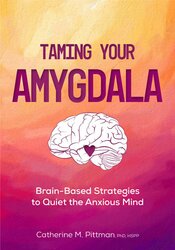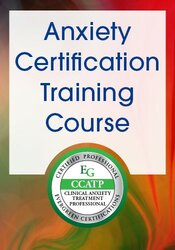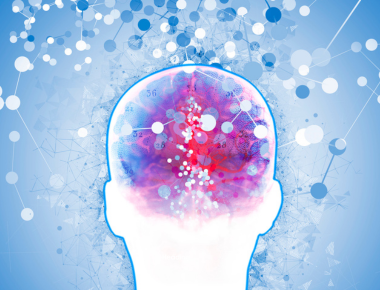Understanding Worry to Heal the Anxious Mind

The piece of your brain that builds anxiety is called the amygdala. It is a tiny, almond-sized, section of brain matter that controls some of our biggest emotions. There are two amygdalae, one on each side of the brain. The amygdala is located deep within the brain, near many other influential structures such as the brainstem, hypothalamus, hippocampus, and ventral striatum. Being in such close proximity to these structures allows your amygdala to create such a profound sense of fear. This also allows it to change our emotions within a fraction of a second, changes that occur outside of our control. For this reason, many researchers have described the amygdala as having the ability to hijack our brains and take control of our feelings. This is why we often feel as if our emotions are out of control.
The core function of the amygdala is to help detect, avoid, and defend against danger. It is in charge of initiating a defensive response to danger that is also found in animals. This reaction is called fear. The amygdala also creates much more than just fear. Because the amygdala triggers fear, the body responds by inhibiting stomach activity, increasing blood flow, and even releases adrenaline. This experience triggers a defensive motivational state that prompts protective actions, but also generates anxiety. When we can clearly identify the danger that our amygdala is reacting to, we refer to it as fear. On the other hand, when we worry about something that may happen in the future, without a present danger, we experience anxiety.
Understanding worry is a great way to train the amygdala and reduce anxiety. Worry arises in the part of our brains residing directly behind the eyes. This area is called the orbitofrontal cortex. It helps us to consider various outcomes to any situation, both good and bad. Our orbitofrontal cortexes are very imaginative, which is why we often worry about problems we have never seen before. Worry can encourage too much anxiety if it is not understood correctly.
To fully understand worry, letŌĆÖs go back to prehistoric times. Humans needed worry to survive. For example, they needed to worry about the consequences of being cold so that they would know to build warm shelters ahead of cold winters, or they worried about what would happen if they got between a bear cub and its mama. Imagining what would happen if things went wrong was a massive key to survival. It helped prehistoric humans plan for harmful events in order to protect themselves from it. The orbitofrontal cortex does the same for us today, just in a different context. Instead of imagining what would happen if we got between a cub and its mama, it makes us worry about what may happen if we fail an important exam or show up late for work.
The first step in getting your sense of worry to work for you is to become aware of your worry. We often worry about things without even being aware of it. As soon as you notice yourself worrying about something, formulate an action plan to fix it. This action prevents the worry from getting out of control and provoking an amygdala reaction. For instance, if you are worried that you forgot to pay your utility bill, you should specify that your main concern is the fact that the bill is not paid and move onto deciding how to fix the issue. In this example, instead of allowing your worry to escape as anxiety about getting the bill paid, you probably called the electric company to make a payment on the bill. The key is to identify and solve the problem causing the worry before it becomes anxiety.
Sometimes worries are more complicated and do not have a clear solution. If your worry includes some uncertainty and youŌĆÖre unsure if making a plan is worthwhile, the answer is yes! Planning is still helpful even if you donŌĆÖt implement it. LetŌĆÖs say that you are hosting a summer picnic. You are worried about a certain guest who often drinks too much and causes problems. Instead of worrying about all of the different scenarios that could occur, triggering anxiety, you spoke to a friend who promised to keep an eye on that guest. They planned to quietly escort the guest out if they became intoxicated. Having this plan in place allowed you to prevent anxiety and enjoy your summer picnic.
While some of our worries can be addressed with problem-solving, many are completely out of our control. LetŌĆÖs say for instance that a loved one is very sick and may pass away, you must learn to cope rather than solve. In this instance you may seek help by speaking to a therapist about healthy ways to cope with this problem. While this action does not solve the problem at hand, it prevents your worry from spiraling into anxiety.
Becoming aware of your worry and addressing it before it reaches the amygdala is a powerful and effective way to reduce anxiety. While worry used to be crucial to survival for prehistoric humans, we no longer need it as a survival mechanism, instead we must prevent it from stimulating anxiety. Addressing your worry, and forming a plan prevents it from reaching the amygdala and triggering an anxious reaction. In situations where a plan of action cannot solve the issue at hand, direct your energy on finding healthy ways to cope with this problem to prevent it from spiraling into anxiety.
Take some time to with the following worksheet, so you can help your clients replace distressing thoughts with more useful coping thoughts.
You can find additional comprehensive information and exercises like these in . Learn to lessen paralyzing worry and debilitating panic with coping skills and brain-based strategies.
The core function of the amygdala is to help detect, avoid, and defend against danger. It is in charge of initiating a defensive response to danger that is also found in animals. This reaction is called fear. The amygdala also creates much more than just fear. Because the amygdala triggers fear, the body responds by inhibiting stomach activity, increasing blood flow, and even releases adrenaline. This experience triggers a defensive motivational state that prompts protective actions, but also generates anxiety. When we can clearly identify the danger that our amygdala is reacting to, we refer to it as fear. On the other hand, when we worry about something that may happen in the future, without a present danger, we experience anxiety.
Understanding worry is a great way to train the amygdala and reduce anxiety. Worry arises in the part of our brains residing directly behind the eyes. This area is called the orbitofrontal cortex. It helps us to consider various outcomes to any situation, both good and bad. Our orbitofrontal cortexes are very imaginative, which is why we often worry about problems we have never seen before. Worry can encourage too much anxiety if it is not understood correctly.
To fully understand worry, letŌĆÖs go back to prehistoric times. Humans needed worry to survive. For example, they needed to worry about the consequences of being cold so that they would know to build warm shelters ahead of cold winters, or they worried about what would happen if they got between a bear cub and its mama. Imagining what would happen if things went wrong was a massive key to survival. It helped prehistoric humans plan for harmful events in order to protect themselves from it. The orbitofrontal cortex does the same for us today, just in a different context. Instead of imagining what would happen if we got between a cub and its mama, it makes us worry about what may happen if we fail an important exam or show up late for work.
The first step in getting your sense of worry to work for you is to become aware of your worry. We often worry about things without even being aware of it. As soon as you notice yourself worrying about something, formulate an action plan to fix it. This action prevents the worry from getting out of control and provoking an amygdala reaction. For instance, if you are worried that you forgot to pay your utility bill, you should specify that your main concern is the fact that the bill is not paid and move onto deciding how to fix the issue. In this example, instead of allowing your worry to escape as anxiety about getting the bill paid, you probably called the electric company to make a payment on the bill. The key is to identify and solve the problem causing the worry before it becomes anxiety.
Sometimes worries are more complicated and do not have a clear solution. If your worry includes some uncertainty and youŌĆÖre unsure if making a plan is worthwhile, the answer is yes! Planning is still helpful even if you donŌĆÖt implement it. LetŌĆÖs say that you are hosting a summer picnic. You are worried about a certain guest who often drinks too much and causes problems. Instead of worrying about all of the different scenarios that could occur, triggering anxiety, you spoke to a friend who promised to keep an eye on that guest. They planned to quietly escort the guest out if they became intoxicated. Having this plan in place allowed you to prevent anxiety and enjoy your summer picnic.
While some of our worries can be addressed with problem-solving, many are completely out of our control. LetŌĆÖs say for instance that a loved one is very sick and may pass away, you must learn to cope rather than solve. In this instance you may seek help by speaking to a therapist about healthy ways to cope with this problem. While this action does not solve the problem at hand, it prevents your worry from spiraling into anxiety.
Becoming aware of your worry and addressing it before it reaches the amygdala is a powerful and effective way to reduce anxiety. While worry used to be crucial to survival for prehistoric humans, we no longer need it as a survival mechanism, instead we must prevent it from stimulating anxiety. Addressing your worry, and forming a plan prevents it from reaching the amygdala and triggering an anxious reaction. In situations where a plan of action cannot solve the issue at hand, direct your energy on finding healthy ways to cope with this problem to prevent it from spiraling into anxiety.
Take some time to with the following worksheet, so you can help your clients replace distressing thoughts with more useful coping thoughts.
You can find additional comprehensive information and exercises like these in . Learn to lessen paralyzing worry and debilitating panic with coping skills and brain-based strategies.
Discover Brain-Based Strategies to Quiet the Anxious Brain

Anxiety shows up in a lot of different ways and can permeate every aspect of your life. The good news is that although it can feel confusing and overwhelming ŌĆō as if things will never get better ŌĆō it is possible to retrain your brain and put yourself back in the driverŌĆÖs seat.
In Taming Your Amygdala, clinical psychologist Dr. Catherine Pittman offers scientific insight, clear explanations, and simple brain-based strategies to help you overcome excessive worry, anxiety, and fear. Based on the principles of neuroscience and cognitive behavioral therapy, the tools in this workbook will teach you the ŌĆ£language of the amygdalaŌĆØ so you can:
In Taming Your Amygdala, clinical psychologist Dr. Catherine Pittman offers scientific insight, clear explanations, and simple brain-based strategies to help you overcome excessive worry, anxiety, and fear. Based on the principles of neuroscience and cognitive behavioral therapy, the tools in this workbook will teach you the ŌĆ£language of the amygdalaŌĆØ so you can:
- Understand how and why your brain gets ŌĆ£hijackedŌĆØ by anxiety and fear
- Identify and cope with anxiety triggers and stuck points
- Develop new, adaptive coping skills to prevent and reduce anxious thoughts and feelings
- Live your life to the fullest, breaking free of the limits of chronic anxiety, paralyzing worry, or debilitating panic
Anxiety Certification Training Online Course

This powerful 2-Day Anxiety Certification Training brings you the latest and most up-to-date anxiety interventions and techniques to help you break through tough roadblocks with your clients. YouŌĆÖll learn from 12 of the biggest experts in the field including world-renowned keynotes Jud Brewer, PhD, and Elliott Connie, MA, LPC. These leading-minds on anxiety will guide you through the latest research on anxiety and how it has changed in a post-pandemic society, plus give you interventions that use easy to digest neuroscience and evidence-based practices like ACT, EMDR, and SFBT to treat even the most anxious client. YouŌĆÖll learn new ways to work with BIPOC clients, as well as those whose anxiety is exacerbated by trauma, OCD, tech-related stressors, and more! Best of all, upon completion of this training, you'll immediately qualify to become a Certified Clinical Anxiety Treatment Professional (CCATP) with Evergreen Certifications!
Meet the Expert:
Catherine M. Pittman, PhD, HSPP, has a background in cognitive behavioral therapy, neuropsychology, fear-conditioning research, and treated anxiety-based disorders in clinical practice for over 25 years. Her experience makes her uniquely qualified to provide a clear understanding of neuroscience and how that informs the selection and application of successful anxiety treatment strategies.
Dr. Pittman is the author of the popular book, Rewire Your Anxious Brain: How to Use the Neuroscience of Fear to End Anxiety Panic, and Worry (New Harbinger Publications). Her new book, Taming Your Amygdala, was published in Spring 2022 (░┼└ų╩ėŲĄ Publishing & Media). Dr. Pittman is a professor of Psychology at Saint Mary's College, Notre Dame, IN. She regularly presents workshops at national conferences and national webinars on anxiety treatment and is an active member of the Public Education Committee of the Anxiety and Depression Association of America.
Learn more about their educational products, including upcoming live seminars, by clicking here.
Dr. Pittman is the author of the popular book, Rewire Your Anxious Brain: How to Use the Neuroscience of Fear to End Anxiety Panic, and Worry (New Harbinger Publications). Her new book, Taming Your Amygdala, was published in Spring 2022 (░┼└ų╩ėŲĄ Publishing & Media). Dr. Pittman is a professor of Psychology at Saint Mary's College, Notre Dame, IN. She regularly presents workshops at national conferences and national webinars on anxiety treatment and is an active member of the Public Education Committee of the Anxiety and Depression Association of America.
Learn more about their educational products, including upcoming live seminars, by clicking here.



